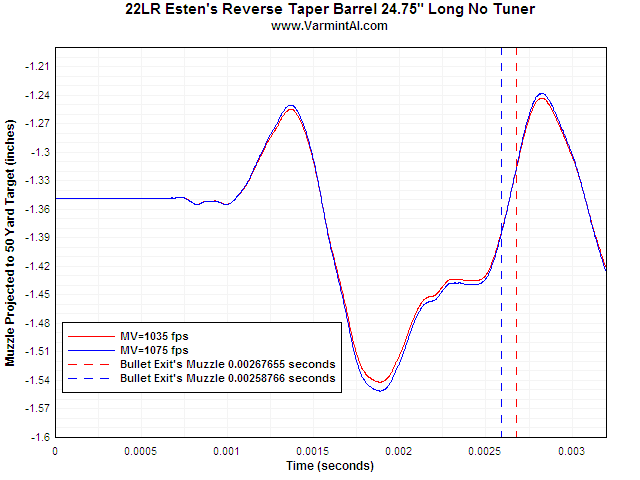M
MKnarr
Guest
Jim Pollard and I have been looking at the possibility of adjusting a tuner using the sound waves caused by firing a round. This technique could be a time and money saver if it worked. The thought was, if there was a way to get the vibration patterns into a computer, we might be able to tell if the tuner was adjusted correctly or not.
Here is a web site where you can see the results. Tuner adjustment using sound
Unfortunately it hasn't worked out so far but the actual vibration patterns caused by the barrel ringing as the round is fired are interesting anyway. Many of us worry about barrel vibrations but few realize that the vibrations that are important occur in less than .003 seconds (the time it takes for the bullet to leave the barrel) for a 22LR and looking at the waveforms we recorded, there isn't a lot going on in that short a time.
Here is a barrel vibration wave that Jim sent to me today.

It appears to be exactly what I would suspect that vibration pattern of a ringing barrel would be when firing a round. It is about .15 seconds long but the only part we are interested in is the first .003 seconds.
There was a question and a lot of speculation on another forum about how long a barrel vibrates after the shot is fired. In our testing it appears to around 1/2 second or less depending on the barrel diameter, shape and length and attachment to the receiver, at least as close as we can measure.
Take a look. It isn't anything earth shattering but it might add just one more piece to the puzzle and we would be interested if anyone had any better thoughts.
Jim B.
Here is a web site where you can see the results. Tuner adjustment using sound
Unfortunately it hasn't worked out so far but the actual vibration patterns caused by the barrel ringing as the round is fired are interesting anyway. Many of us worry about barrel vibrations but few realize that the vibrations that are important occur in less than .003 seconds (the time it takes for the bullet to leave the barrel) for a 22LR and looking at the waveforms we recorded, there isn't a lot going on in that short a time.
Here is a barrel vibration wave that Jim sent to me today.

It appears to be exactly what I would suspect that vibration pattern of a ringing barrel would be when firing a round. It is about .15 seconds long but the only part we are interested in is the first .003 seconds.
There was a question and a lot of speculation on another forum about how long a barrel vibrates after the shot is fired. In our testing it appears to around 1/2 second or less depending on the barrel diameter, shape and length and attachment to the receiver, at least as close as we can measure.
Take a look. It isn't anything earth shattering but it might add just one more piece to the puzzle and we would be interested if anyone had any better thoughts.
Jim B.






